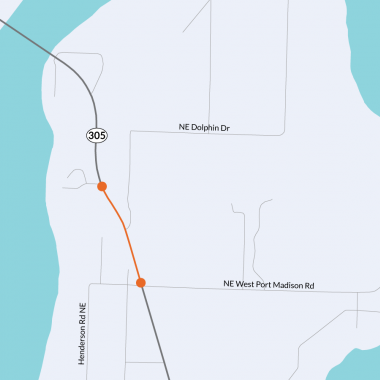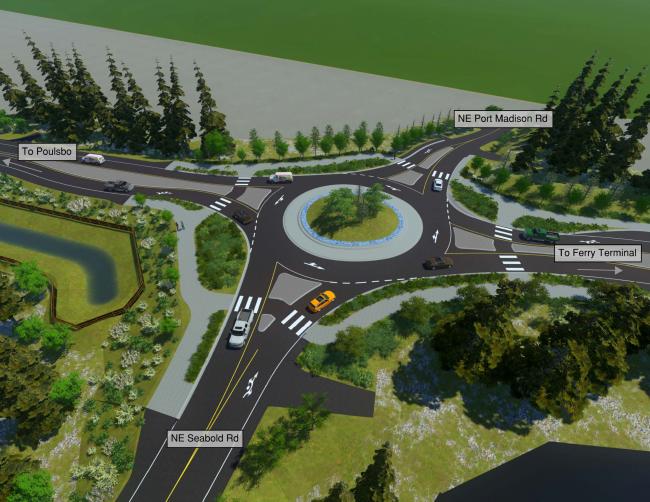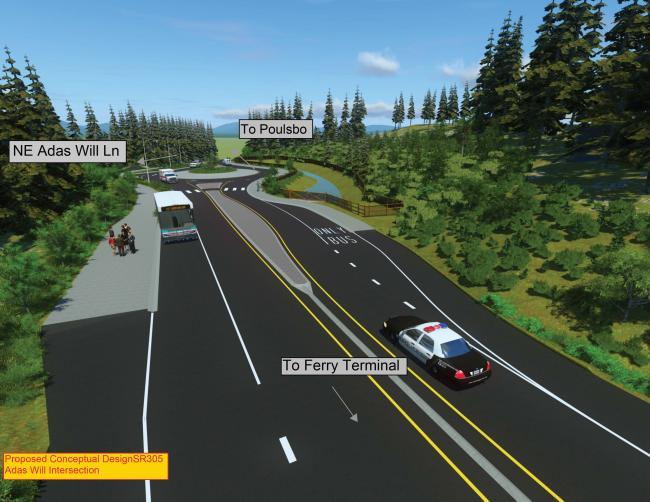The project process initially began with an effort by the West Sound Alliance, which produced a report on Strategic Corridor Investments. Following the report, the Washington State Legislature funded the SR 305/ Winslow Ferry to Hostmark St. – Safety Improvements project. The 2015 Connecting Washington transportation package included $36.8 million for investments in the corridor. Kitsap Transit, working with community partners, followed up with a study that has established a vision and goals for this corridor (PDF 6.4MB).
- A single-lane modern roundabout at Northeast Adas Will Lane. The three-legged roundabout will serve both directions of SR 305 and Northeast Adas Will Lane.
- A single-lane modern roundabout at Northeast West Port Madison Road. The four-legged roundabout will serve both directions of SR 305, Northwest West Port Madison Road and Northeast Seabold Road.
- The improvements also include a feature at the intersection of Agatewood Road Northeast which will become a right in/right out intersection. A right in/right out – typically built with raised concrete islands - limits access to right turns off SR 305 and right turns onto SR 305. This feature reduces the potential for collisions as a right in/right out eliminates left turns in front of oncoming traffic.
- Users of the Agatewood Road – who have told WSDOT is very difficult to turn left onto SR 305 – would instead turn right onto the highway and then return via the roundabout at Northeast Adas Will Lane.
Why we use roundabouts
The centerpiece of the proposed improvements includes roundabouts along the corridor.
Due to a number of benefits, WSDOT currently has about 100 roundabouts on other state highways in Washington. These benefits include helping reduce the potential for crashes while keeping traffic moving. There are several reasons why roundabouts help reduce the likelihood and severity of collisions:
- Low travel speeds – Drivers must slow down and yield to traffic before entering a roundabout. Speeds in the roundabout are typically between 15 and 20 miles per hour. The few collisions that occur in roundabouts are typically minor and cause few injuries since they occur at such low speeds.
- No light to beat – Roundabouts are designed to promote a continuous flow of traffic. Drivers need only yield to traffic before entering a roundabout; if there is no traffic in the roundabout, drivers are not required to stop. Because traffic is constantly flowing through the intersection, drivers don't have the incentive to speed up to try and "beat the light," like they might at a traditional intersection.
- One-way travel – Roads entering a roundabout are gently curved to direct drivers into the intersection and help them travel counterclockwise around the roundabout. The curved roads and one-way travel around the roundabout eliminate the possibility for T-bone and head-on collisions.
WSDOT's project on Bainbridge Island is expected to begin summer 2023 and be completed fall 2024.
Milestone
Oct. 23, 2023
Start of construction
October 2024
End of Construction
Proposed 305 roundabout at West Port Madison Road
Proposed roundabout at Northeast Adas Will Lane



